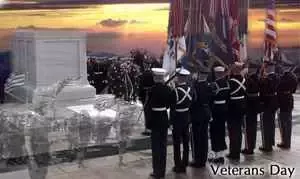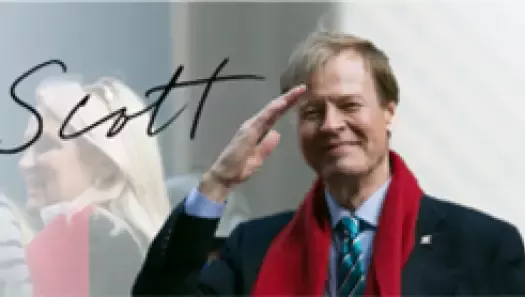Cover Story: DoD Secretary Offers Encouragement In Veterans Day Speech

Because of the ongoing worldwide war against terrorists, this Veterans Day is different from previous years. The events since the attack on our nation -- and on world order itself -- gave rise to a fresh appreciation for those in uniform. Since September, Americans young and old alike have instinctively turned to our military as the symbolic, yet also very real, source of national strength.
But sometimes, even in times of national crisis, we sometimes overlook the sacrifices of those who came before us. I’d like to begin with a true story about a captain from Fort Belvoir, Virginia. The captain was approaching the post medical facility when she noticed a veteran walking toward her. The old soldier, stooped over and walking slowly, appeared to be about 80 years old. The captain barely gave the veteran a second glance because coming up immediately behind him was a full colonel. When it was time to render her salute to the colonel, the old veteran was only a few paces from the captain.
"Good morning, Sir," the captain said, saluting sharply.
The veteran immediately came to life, totally transformed by the captain’s greeting. Thinking the salute was intended for him, the veteran straightened up, returned her salute and exclaimed with vigor, "Good morning, Captain."
Meanwhile, the colonel was in the process of returning the salute when he realized what was going on. The colonel stopped in mid-salute, remained silent, exchanged glances with the captain, and continued on his way unobserved by the veteran.
A Pause to Remember
This story illustrates the importance of Veterans Day, when the nation pauses to salute all those who have served and those who continue to serve in uniform. It honors those who have served on active, Reserve or Guard duty, and those who served during times of peace as well as war. This day honors those who served two years, or an entire career.
As we see in the story of the old veteran, even a small amount of recognition can go a long way. I hope that most Americans think about the importance of our nation’s military and its veterans more than just one day each November. But even this one day of reflection means a great deal to those who have worn the uniform. This tradition began in 1919, as Armistice Day, to recognize those who died fighting in the First World War. Congress broadened the scope of this recognition in 1954 to honor all veterans.
Of course, Veterans Day honors those who have served in all the services --soldiers, sailors, airmen, Marines, and Coast Guardsman ... those who joined, those who were drafted, and those who became career soldiers ... those who served in the front lines, the supply lines and guarding the shores back home ... and yes, those serving in peacetime . . .
[W]ith the September 11th terrorist attacks on our own cherished land, Americans everywhere have uncovered a great pride and faith in our nation’s veterans. Because of them, we are free. With today’s soldiers, we will remain free.
Veterans Day does much more than set aside one day to honor our proud veterans. Hopefully, the impact of this annual tradition helps extend the spirit of honor and gratitude throughout the year.
You may not think it would be important to rely so heavily on a day of symbolism. But, like it or not, an important part of our heritage has often involved a detached view of the military. Once a threat passes, our nation tends to take those in uniform for granted.
Go, Army
Peacetime -- like the years between the two world wars -- has always been a time when the military suffered because of our country’s non-militaristic mentality.
From new recruits heading off to basic training, to the business owner down the street who balances civilian life with the military in the reserve components, Veterans Day helps everyone appreciate the enormous amounts of service and sacrifice being performed by folks all around them.
Standing before you today as an Army representative, I’d like to discuss Veterans Day with an Army green vantage point, instead of the purple you get when you mix all the military services’ colors.
The Army is unique among the services in many ways. The U.S. Army was the first military service. It actually predates the nation itself, having been created 226 years ago, one year before the colonists declared independence in 1776. Since that time, America has relied on the Army to stand "on point" for the nation’s vital interests.
From those soldiers who have stood guard in peacetime to those who have seen the terrors and inhumanity of combat -- and those who paid the ultimate sacrifice -- our soldiers have been there for America.
We in the Army, like our sister services, are proud of the dramatic improvements made in joint service cooperation during the last two decades. The increasing use of joint force planning and training is a testimonial to the innovation occurring within our defense establishment.
But having said that -- and forgive me those of you who’ve served in our sister services -- the Army has served as the cornerstone of America’s presence throughout the world.
From the deadly beaches at Normandy, to jungle warfare in South Vietnam, the vast deserts of Iraq, or the hillsides of Bosnia-Herzegovina ... the American soldier has contributed the brunt of the force required to provide sanctuary and hope for the weak and oppressed.
The bottom line has been and still is -- even with today’s high tech weapons -- to achieve our missions of deterrence and, if necessary, military victory. For that, America relies on its Army. The Army presence, sometimes referred to as "boots on the ground," consists of large or small forces, but the common ingredient is the individual soldier.
The importance of the individual soldier is being emphasized in the Army’s new recruiting campaign and new slogan launched earlier this year: "An Army of One." Where the previous generation of soldiers joined under the slogan "Be All You Can Be," young people today are being shown that while teamwork is certainly a virtue, their individual strengths make them valuable to the Army and to their country. . .
Beginning as early as basic training, our soldiers learn right away the importance of the individual -- how one person can make a difference. If this spirit isn’t uniquely American, then perhaps it is unique to soldiers who protect democracies. The importance of the individual, and how they can contribute to the whole -- our "Army of One" -- is as true for the basic trainee as it is for the West Point or ROTC cadet.
I hope we can direct some of our thoughts today to these brave soldiers -- men and women, enlisted and officer -- stationed throughout the world. Six months ago at the commencement address for the United States Military Academy, Deputy Secretary of Defense Paul Wolfowitz spoke to the cadets about how they would have to deal with the unfamiliar and the unexpected.
He told the West Point graduates they would be manning the walls behind which democracy and freedom flourish. He said their presence will reassure our allies and deter the enemies of freedom around the world. He told them to prepare to be surprised and to have courage.
Finally, he quoted General Eisenhower’s words to troops about to storm the deadly beaches at Normandy: "You are about to embark on a great crusade. The eyes of the world are upon you. The hopes and prayers of liberty-loving people everywhere march with you."
Process of Transformation
Even before the terrorist attack in September, the Army had begun the process of transformation to meet the changing security needs around the world and of the United States itself. That is our crusade for this generation. Once completed, the transformation will change the Army into a lighter and more lethal force, maintaining America’s Army as the world’s dominant land force.
The new Secretary of the Army, Thomas White, a retired brigadier general and most recently a corporate CEO, has been busy since his May appointment in outlining the various components of this transformation.
Secretary White has seen the Army successfully transition before -- from an Army returning from Vietnam, to the Army that won the Cold War. "Seen in the context of the 225-year history of our Army, this imperative to change is not new," he told Senators during his confirmation hearing.
He continued with his testimony saying, "Transformation encompasses every aspect of our Army. It is more than merely divesting ourselves of obsolete systems and purchasing new ones...Every aspect of the Army -- doctrine, organization, training, leadership, material and equipment, recruiting and advertising, acquisition, infrastructure, and much more -- must all change together in a holistic manner."
Many of you have probably already heard of one of the symbols of this transformation: the black beret. While initially receiving significant news coverage over the controversial nature of this change, the berets are being well-received. Since June 14, the Army’s Birthday, the berets have been in distribution throughout the Army, and are having the desired impact of increased morale.
We’ve determined that it’s possible to raise the overall pride among all of our soldiers while still preserving the unique heritage and esprit-de-corps of our specialized units which previously had exclusive use of berets.
Although the Cold War has ended and appears to have eliminated an obvious threat -- America’s previous opponent, the Soviet Union -- we’re left with a world still dangerous, filled with less certain threats. The transformation will help improve the readiness of our units to meet future threats.
In remarks last year to the Association of the United States Army, Army Chief of Staff General Eric K. Shinseki addressed the issue of readiness and the transition as a part of the overall Army vision. He said the transformation will make the Army "more strategically responsive and dominant at every point on the operational spectrum. It will take a more responsive, more deployable, more versatile, more agile, more lethal, more survivable, and yes, more sustainable Army. We are going to deliver on transformation -- our soldiers are counting on it."
Readiness is increased by taking care of soldiers, and also by looking after their families. Readiness is also achieved by focusing on core missions, and the Army intends to identify those areas outside the Army’s prime specialties and seek outside solutions.
Showing Appreciation
Like that 80-year-old saluting veteran, coming out of the post clinic, we all know the importance of being appreciated. Even if it happens to be just one day. Veterans are a hearty lot. Having the honor of wearing the uniform is enough thanks for most of them . . .
What does Veterans Day mean? What is the overall significance of a random salute captured by an old veteran? It comes down to one sentence - one phrase that you can never hear too often in a democracy: Freedom is not free. . .
SOURCE: Veterans News and Information Service



